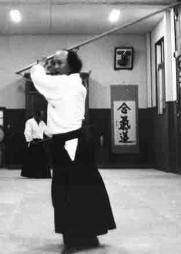Aikido Founder O-Sensei Ueshiba Morihei
AIKIDO - THE HEART AND ORIGIN OF AIKIBOJITSU
Aikido is a sophisticated and powerful martial system based upon the principles of non-resistant power. Created in the mid 1900s by Master Morihei Ueshiba O'Sensei, Aikido is now practiced by a wide spectrum of serious individuals worldwide as a Way by which to approach the challenges of life. Aikido is meditation as much as it is a martial art form. A major part of Aikido study involves work with a staff; Ueshiba O'Sensei was a master of staff work, and considered it one of Aikido's foundational pillars.
AIKIBOJITSU - THE ART OF THE STAFF
Aikibojitsu's philosophy and technique with the staff resembles the philosophy and technique taught at the Aiki Kumano Juku Dojo in the early 1970s. But due to many factors, Aikibojitsu has come to be substantially different from its martial parent. As an example, in addition to focus upon achievement of control of uke (the attacker), Aikibojitsu also places emphasis upon doing so in light of the exponential nature of Reality (for a complete explanation of this topic, see the book Aikido, Aikibojitsu and the Structure of Natural Law (may be purchased elsewhere in this site.)
Aikibojitsu is a highly sophisticated art form. Through understanding of the theoretical foundations and practical techniques of Aikibojitsu practitioners to come to a deep and profound understanding of the reason why optimized techniques take the forms that they do. Understanding of where and how power and silent stillness are best expressed allows Aikido practitioners, and serious practitioners of other martial arts, to understand the hidden complex web of forces that underlie perfection in movement.
AIKIBOJITSU FOUNDER JOHN THOMAS READ
Every advanced art form is built upon the effort of dedicated individuals who have devoted their lives to their work. Aikibojitsu is such an art form, the product of a very special lineage that began in the inspired work of Master Morihei Ueshiba O'Sensei. Ueshiba sensei spent his entire life studying martial arts, and became an acknowledged master in several schools of jiu-jutsu and swordsmanship. But his real accomplishment was the creation of Aikido, a powerful and beautiful martial system based in compassion, non-resistance, and spiritual understanding.
O-Sensei training with MIchio Hikitsuchi Sensei
One of Ueshiba Sensei's top students (soto deshi) was Michio Hikitsuchi, who also spent his entire life devoted to study of martial arts. Hikitsuchi Sensei, himself an acknowledged master of swordsmanship and staff work, was also a Shinto priest, and all those who trained with him in the Kumano Juku Dojo were deeply affected and influenced by the powerful spiritual focus of his teaching. Hikitsuchi sensei was one of a very few who were promoted to 10th dan in Aikido by Master Morihei Ueshiba.
Tojima Sensei
Yasushi Tojima was a senior teacher at the Kumano Juku Dojo, known for his unpredictable nature, ready sense of humor, and explosive intensity. Tojima sensei was central to the creation and development of Aikibojitsu, spending time and energy as mentor to Tom Read Sensei, Aikibojitsu's founder.
John Thomas Read Sensei (Tom Read) began formal Aikido study in 1969 as a way to broaden and deepen his study of Zen meditation. In 1974, Read Sensei moved to Japan where he studied under Masters Michio Hikitsuchi, Yasushi Tojima, and other senior teachers of the Aiki Kumano Juku Dojo. After returning from Japan, Read Sensei opened Northcoast Aikido in 1977 with formal written sanction from Master Michio Hikitsuchi. Read Sensei began to develop the staff work of Aikibojitsu in 1985 after he experienced a powerful spiritual awakening to the fullness of Aikido's foundations.
Read Sensei
In the study of non-resistance, it is important that nage find a way past uke's imperfections. Uke is often somewhat uncoordinated, making it difficult at first to see the deeper principles in action. It is a great deal to ask of uke, that his strikes be accurate, precise, and honest. Uke may well find the requirements placed on him in non-resistant martial practice to be especially difficult and might well be reluctant to willingly go beyond socially acceptable training levels and enter into a level of energy criticality.
Aikibojitsu staff work 'simplifies' the very complex open-hand work of technical Aikido, replacing the unpredictability of a thinking human being with the simple singularity of a stick of wood. This piece of wood is pure and bound to truth. It is an entity of the manifested unknown, and therefore acts fully in accordance with the dictates of decontractive intent.
The staff can always be counted on to respond with absolute commitment and honesty, and therein lies one of the key elements necessary to the deepening of nage's study. The staff's absolute truthfulness reveals immediately, accurately, and unflinchingly the correctness (or lack thereof) of nage's intent in the preformal stream.
Through the tecniques of Aikibojtsu, the practitioner comes to familiarity with the surfaces of determinative structure. In possession of that familiarity, nage may then shift to work with those same structures, but now with uke, a human being full of chaotic imperfection. In open-hand technique, correct use of preformal structure in technical application is thus greatly eased. The technical moves and timings of Aikibojitsu have becomes embedded in the traces of the brain and the muscles, making it a much simpler task to isolate and utilize upstream structures in paired work with the more complicated human being.





